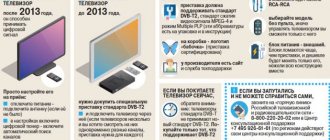It is difficult for us to imagine our life without television. Even if we don't watch it, it is still a vital part of our culture. Meanwhile, this invention is just over 100 years old. Television, whose history of origin and development fits into such a short period by the standards of history, has radically changed our communication, attitude to information, our states and culture.
Invention
The history of the invention of television lasts almost 100 years. Unlike radio, which was discovered simultaneously by two people in different parts of the world, television is a complex, step-by-step creation of technology. Each country has its own version of the history of the discovery of television, which emphasizes the participation of its scientists in this process. This is explained by the fact that the technology was created by entire teams in the form of solving individual technical problems. In order not to go into technical details, we will name the main engineers involved in this event.
At the origins is Willoughby Smith, who invented the photoelectric effect in selenium. The next stage of the discovery is associated with the name of the Russian scientist Boris Rosing, who patented an electrical method for transmitting images. Also, contributions to the discovery were made by P. Nipkov, D. Baird, J. Jenkins, I. Adamyan, L. Termen, who independently create transmitters for broadcasting images in different countries. The next round of technology development is associated with the advent of electronic television. M. Dickmann and G. Glage documented the creation of a tube for transmitting images. But the first patent for the technology, which is still used in televisions today, was received by Boris Rosing in 1907. Then a whole galaxy of scientists worked to improve the technology. And in 1931, engineer V. Zvorykin creates an iconoscope, which is considered the first television. Based on this invention, F. Farnsworth creates a kinescope. This is how the history of the creation of television briefly looks like.
Scientific activity
For 40 years of his scientific activity, Boris Rosing was engaged in the study of various phenomena and the development of technical systems. He has more than 25 patents, privileges and certificates of authorship, as well as over 50 major scientific publications.
Boris Rosing
At the beginning of his career, Rosing studied the theory of dynamic magnetism of non-crystalline homogeneous bodies and crystals. He was able to explain the phenomenon of magnetotraction, in which the length of iron wires changes due to magnetization. The reason for this change is hysteresis (a property of physical, biological, etc. systems, the instantaneous response of which to influences applied to them depends, among other things, on their current state, and the behavior of the system over a time interval is largely determined by its prehistory). Rosing discovered this phenomenon in 1894 in parallel with the Japanese scientist Hantaro Nagaoka. Boris Rosing was also involved in the creation of batteries with a moving layer of electrolyte, and studied the conversion of thermal energy into electrical energy and vice versa.
In the early 1890s, he was fascinated by the works of Porfiry Bakhmetyev, a physicist and experimental biologist of Russian-Bulgarian origin. Bakhmetyev developed a “telephotographer” - a means for transmitting images at a distance. And he formulated the principle of television: “The image must be decomposed into individual elements, the elements are sequentially transmitted and reassembled into a single whole.” Guided by this principle, Rosing conducted research in the field of television. It is worth noting that the term “television” was first uttered in 1900 by Konstantin Persky. However, in the USSR it began to be used frequently only in the 1930s. Before this, the terms “far vision”, “radioscopy”, “electrovision” were used.
By the beginning of the twentieth century, devices had already been created that scanned the image into elements and reassembled it mechanically, and transmitted the electronic signal using radio. In his first studies, Rosing tried to combine mechanical and electronic devices in one system. He used a Nipkow disk (a circle with small holes marked in an Archimedean spiral) to divide the image into lines and transmitted them to an electronic signal receiver - a cathode tube, where the cathode beam projected the image onto a photocell.
During the experiments, the scientist realized that electronic systems are more practical and promising than mechanical ones. Moreover, by this time Rosing already had experience in researching electrical energy and the properties of magnetism. Rosing used a Crookes–Brown cathode tube as an image reproduction device. In 1902, he conducted an experiment: the receiver was a cathode tube, and the transmitting device was an electric bath with four electrodes connected to deflecting coils of the tube. The electrodes sent signals to the tube. The metal rod moved across the bath in the electrolyte layer, acting as a light beam. The movement of this rod exactly repeated the cathode beam in the tube, which drew various shapes. Rosing noted that it was impossible to transmit images of different brightness using a cathode tube. Then, to display halftones, the scientist supplemented the tube design with plates that modulated the intensity of the electron beam by changing the number of electrons hitting the screen. So the cathode tube from the oscilloscope turned into a television tube - a prototype of the kinescope. Rosing also improved the mechanical part of the device: instead of a Nipkow disk, he began to use a system of two multifaceted Weiler mirror drums, rotating at different speeds. Later, the inventor replaced one of the Weiler drums with movable glass for continuous alternation of lines. This is how he achieved image expansion up to 2400 elements.
In 1907, Boris Rosing filed an application for the invention “Method of electrical transmission of images” to obtain a privilege (analogous to a modern patent). In 1908, based on it, he received patents in England and Germany, and in 1910 - in Russia. The main difference between Rosing's invention and the developments of other engineers was that he was able to create a working physical device, and not just describe it in theory. He introduced an innovation to the process of image transmission: instead of a mechanical transmission method, he began to use an electronic one.
Schematic of an electronic television receiver from a privilege received by Rosing
On May 9, 1911, Rosing repeated the experiment in the presence of the commission. It broadcast an image of four white stripes on a black background. Of course, two-color imaging is only the first step in the era of electronic television, but it was this step that marked a breakthrough. Rosing proved the possibility of transmitting images using an electron beam.
In 1912, Rosing received well-deserved awards for his work. He was awarded the Gold Medal and the Siemens Honorary Prize for his services to electrical telescopy.
Rosing knew he was on the right track. He improved the device, remaking it each time. In 1913, a vacuum tube with indirectly heated cathode and magnetic focusing of the electron beam was manufactured. By changing the charge and discharge of the capacitors to a periodic one, the scientist obtained the deflecting currents and voltages necessary for clearer image transmission.
The main problem in the research was that the state did not see any prospects in television and therefore did not support them financially. Rosing carried out most of the development at his own expense. The scientist himself believed that transmitting images over a distance could find wide application in the future: “Undoubtedly, the time will finally come when electric telescopy will spread everywhere and become as necessary a device as the telephone is now. Then millions of such devices, such “electric eyes”, will comprehensively serve public and private life, science, technology and industry... The riches of most of the surface of our planet, which is still hidden under the covering water, will be revealed to us... It will be possible to penetrate in the same way into mountain crevices and extinct volcanoes and look inside the solid shell of the Earth. The doctor will be able to use such an electric eye when examining the insides of a patient, while being far from him. An engineer, without leaving his office, will see everything that is being done in workshops, warehouses, and work.” Rosing wrote this in his book Electrical Telescopy (Vision at a Distance). Immediate tasks and achievements" in 1923.
Work principles
In 1928, with the beginning of regular broadcasting, the real history of the emergence of television begins. Ulysses Sanabria was the first to use radio waves to transmit images and sound. The principle of operation of television is a special projection of the image onto a photosensitive plate in a cathode ray tube. For a long time, the history of television was associated with the improvement of this tube, which led to improved picture quality and an increase in screen surface. But with the advent of digital broadcasting, the principle changed; now a kinescope with a ray tube is no longer needed. It uses a completely different way of transmitting images. It is encoded and transmitted using digital channels and Internet systems.
Biography
Boris Lvovich Rosing in St. Petersburg on May 5, 1869. His ancestors were among the European scientists whom Peter I invited to Russia to develop science and technology. Lev Rosing, an active state councilor, in his spare time was engaged in creating precision watches and a flying machine in an amateur workshop in the attic. It was his father who instilled in the scientist a love of invention: they spent a long time in the attic creating models. Already at the gymnasium, Boris Rosing was interested in physics. In 1887, after graduating from high school with a gold medal, he entered the Faculty of Physics and Mathematics of St. Petersburg University.
In 1893, Rosing joined the St. Petersburg Technological Institute (PTI) as a laboratory assistant. In parallel with his research, he taught practical classes in physics. In 1898, he was elected to the position of teacher and began lecturing on electricity and electrometry. After 9 years, Rosing became the dean of the electromechanical faculty of PTI. After the October Revolution, the scientist and his family had to move to a quieter and safer Yekaterinodar (Krasnodar). In 1918, he actively participated in the opening of the Kuban Polytechnic Institute, the first higher educational institution in the North Caucasus. There he took the position of vice-rector, dean of the Faculty of Electromechanics. Continuing to work in Ekatrinodar, the scientist looked for ways to return to his native institute.
In 1920, Rosing received an offer to continue his research in the USA and emigrate from Russia. He refused, answering: “I am a Russian person and I am not going to sell my brain to foreigners.” Perhaps if he had made a different decision, his life would have turned out differently... But history does not have a subjunctive mood.
Postage stamp in honor of the inventor of electronic TV, Boris Rosing
In 1922, he moved to Petrograd and became a professor of physics at the Second Polytechnic Institute. He managed to return to the Technological Institute (now Leningrad Institute), restore the laboratory and continue research only in 1924. Rosing worked there until the end of 1930.
In December 1930, Rosing was detained on charges of financial assistance to counter-revolutionaries. The reason was that he lent a small amount of money from a subscription list to a needy fellow teacher, a former tsarist officer and opponent of the revolution. And in February 1931, the scientist was exiled to a sawmill in Kotlas for three years without the right to teach or conduct research. Moreover, he had to look for housing on his own. The scientist could only afford a removable bed behind a curtain in the kitchen in an apartment in which 12 other people lived. Rosing did not receive free food stamps; his family sent him food and money. Life without the opportunity to work was tantamount to death. Then he began giving lectures to factory workers in the evening.
In 1932, thanks to the help of friends and family, Rosing was hired as a laboratory assistant at the Arkhangelsk Forestry Institute (ALTI). There he could not continue his research to improve the method of image transmission, but he began to develop a device to help the blind navigate and a cardiograph for the local hospital. His financial situation remained disastrous: prices for renting a room and food in Arkhangelsk were significantly higher than in Kotlas. Rosing did not even have enough money to buy kerosene for the primus stove. The scientist was helped by a colleague who brought him home-cooked food. Poor conditions undermined his health. In recent months he was often sick.
The last days of Rosing's life are recorded by the landlady Alexandra Popova, from whom he rented a room. One day, returning after work, Rosing was riding on a tram and carrying a container of soup. The tram turned sharply, and soup spilled onto the coat of the woman sitting next to her. She caused a scandal, Rosing could only apologize and tried to clean the stained fabric. This everyday event shocked the scientist and affected his condition. Two days later, on April 20, 1933, he died of a cerebral hemorrhage. Boris Rosing was buried in the local cemetery. Only in 1957 was Boris Rosing posthumously rehabilitated. In the summer of 2005, the scientist’s remains were reburied and a monument was erected at the Vologda cemetery in Arkhangelsk. The former grave was located on the edge of the cemetery and was partially flooded.
Types of television
The long history of the development of television has led to the formation of numerous types. Firstly, it is divided into black and white and color. Until 1950, all televisions showed only black and white pictures. Two color television standards: NTSC and SECAM are still in use throughout the world. Television can also be divided into paid and free. In every country there is a set of channels that anyone with a TV can watch. But there are also channels whose signal can only be seen for money. Forms of payment may be different, but the share of such television steadily remains at 30% of the entire market.
Based on the method of signal transmission, television can be divided into:
- terrestrial, in this case the television receiver receives a signal from a television tower, this is the most familiar and widespread method of broadcasting;
- cable, in this case the signal comes from the transmitter via a cable connected to the TV;
- satellite – the signal is transmitted from a satellite and is picked up by a special antenna, which transmits the image to a special set-top box connected to the TV;
- Internet television, in this case the signal is transmitted via the Internet.
Based on the method of encoding information, television is divided into analog and digital. The second is of higher quality thanks to the latest encoding and transmission standards.
Television was invented by a Murom resident, and the Armenians made it color
Television has a triple anniversary this year. 90 years from the day the image was obtained using a cathode ray tube. St. Petersburg resident Boris Rosing succeeded. Exactly 70 years ago, Soviet low-line electromechanical television appeared. And 65 years ago in England, for the first time in the world, regular television broadcasting began using modern electronic standards. Looking at some cool half-wall flat-screen Samsung today, you would never think that mostly Russian blood flows in its electronic veins. But even the word “television” itself was coined by an engineer from St. Petersburg, Konstantin Persky. It happened in 1900 at a scientific conference in Paris. But if the godfather has been established for certain, the TV does not have the surname of the “father” - several groups of engineers came up with the device (this is not a radio, where only two lay claim to “paternity” - our Popov and the Italian Marconi). The first TV game is “Guess the Officer” Moscow. Summer 1927. In the office of the People's Commissar of Defense, People's Commissar Kliment Voroshilov and the legendary Semyon Budyonny are sitting and enthusiastically... watching TV. High authorities are experiencing the miracle of military technology. “In April 1963, Marshal Budyonny told me, surprised, how he watched “TV” in the mid-20s,” says television scriptwriter Alexander Rokhlin in the book “This is how far-sighting was born.” — This device was strictly classified and was intended for the Border Troops. Before sending it to the border, it was decided to install it in the office of the People's Commissar of Defense. The People's Commissar invited Budyonny to his place, and they began a kind of game. The operator technician pointed the transmitting camera at a visitor walking through the courtyard of the People's Commissariat, and they tried to guess who was shown on the screen. “We were so excited,” the marshal recalled, “that at first we didn’t even recognize people we knew well. But this was only the case in the first minutes, and then we almost unmistakably began to recognize who the operator was showing.” This device was created by engineer Lev Sergeevich Termen, a descendant of the Huguenots who fled France after St. Bartholomew's Night. The screen of the “Theremin TV” was huge - 150 by 150 cm, and the screens of Western models at that time were no larger than a matchbox. From this electromechanical installation there was one step left to real electronic TV, but... Theremin was sent as our resident to the USA. There he became a millionaire, communicated with Isadora Duncan and Charlie Chaplin, and invented the world's first color music device. Lev Theremin returned from the States to his homeland at the beginning of the war. He was awaiting arrest, and his unique equipment was broken. Then, after the camps, Termen worked together with Korolev and Tupolev... Lev Sergeevich died in 1993. Television is the “child” of Russian emigrants “It’s so good that Zvorykin left and invented television there. If he had not left the country, he would have ascended to Golgotha like everyone else!..” These are the lines of Bulat Okudzhava. Vladimir Kozmich Zvorykin invented an iconoscope for a television camera and a kinescope for a television receiver - two irreplaceable parts. Vladimir Kozmich was born in Murom*, fought in the First World War, and in 1919 he left for America - electronic television was his dream, and in the burning post-revolutionary Russia he saw no prospects for its creation. Zvorykin lived for 92 years, died in 1982, and managed to patent inventions even in the field of guided missiles. But when the Americans tried to assign the title of “father of television” to Zvorykin, he was irritated: “I invented the kinescope and I don’t pretend to anything else! Everything else is empty newspaper chatter.” But also “our former” - David Sarnov, who came to the States from near Minsk, did not refuse the high-profile title. In 1944, at the first meeting of the Society of Television Broadcasters, he was named the "Father of Television". In 1912, Sarnov, then a young telegraph operator, received SOS signals from the sinking Titanic. This alone was enough to go down in history. But the enterprising engineer came to work for the company of Guglielmo Marconi (the same one who invented radio) and by 1930 established control over the Radio Corporation of America (RCA) created by the Italian and its subsidiary radio network NBC! He invited Zworykin and invested $50 million in television development. And the third of those whom Americans consider the “founding father” of television is also, don’t laugh, a native of Russia. His name is William Paley. Once in the States, he successfully married the daughter of newspaper magnate Hearst and actively became involved in his father-in-law's business, becoming the founder of the CBS company. By the way, the first video recorder was invented at the American company, the founder and leader of which was a Russian, Alexander Matveevich Ponyatov (the first letters in the name of the company are his initials). Who is the real “father” of television? Among those who “did not leave” was St. Petersburg engineer Boris Lvovich Rosing. It is he who is considered the founder of electronic TV all over the world**: Rosing proved that a cathode cathode ray tube can be used to receive signals - the same electronics that now underlies television technology. The current television screen is the flattened end of a cathode tube. It was with Rosing that Zvorykin studied. In 1931, Rosing was repressed and exiled to Arkhangelsk. He barely managed to get permission to at least continue working - at the Arkhangelsk Forestry Institute. A professor named Pokotylo brought him cans of soup from home so that the scientist would not go hungry. One day Boris Lvovich was driving home with these cans (and he settled on the street named after the inventor of radio, Alexander Popov, and the landlady was also called Alexandra Popova), the tram swayed at a turn, and the soup stained the clothes of a citizen standing next to him. “All sorts of people ride here!” - the lady squealed. The inventor rushed to her, tried to clean the dress... And at home he lay down on the bed, turned his face to the wall and died a few days later. **Are you already confused about inventors? Television is a complicated thing. First, Russian physicist Alexander Stoletov proved that it was possible to convert light into electrical signals. Then they learned to transmit them wirelessly. And then it was necessary to make a picture from these signals again - this is what Rosing managed to do. The rest is a matter of technology, which Zvorykin took up. Armenians invented color television! Hovhannes Adamyan tried to invent color television at the beginning of the century! He was born in Baku, studied in Berlin, and in 1907 received a patent for a two-color TV device (a red and white image was transmitted over wires over 600 km). In the transmitting apparatus, one gas-light tube emitted white light, the other red. The principle of simultaneous color transfer is still used today. But for a real color picture, three colors are needed - and Hovhannes Abgarovich invented the three-color device “erates” (translated from Armenian as “visionary”), in 1925 he even showed several experimental broadcasts in Yerevan! True, Adamyan’s color television was mechanical, not electronic, that is, the image in it was transmitted using a rotating disk with slots. Regular color broadcasting began in the United States in 1953. Today, TVs cost the same as when they were born. The first mass model of the American RCA TV had a 12.5 by 22.5 cm screen and cost $199. True, there was no sound in it. It was necessary to place a radio nearby and tune it to the desired wave. In the early 50s, such delights appeared as Teleton TVs with a round screen or “boxes” with doors for the screen (so that no one from there could spy on the owner while the TV was turned off!). The first TV stars were made up to look like frogs. In the USSR, an application for a “radio eye” similar to the Zvorykin iconoscope was submitted in 1931 by Semyon Isidorovich Kataev. Two months earlier than the “American” Zvorykin! But we are behind the Americans in turning television into mass entertainment. When test broadcasts from the television center on Shabolovka began in 1938, there were only... 30 televisions in Moscow. Most likely, the first television viewers were employees of the television center and the country's top management. Our first electronic televisions, “TK-1,” exactly copied those overseas (by the way, the equipment at the Shabolovsky television center was American). But before that, in Moscow, for almost 11 years (from 1931 to 1941), a short-line mechanical TV studio broadcast programs. It was located on the bell tower of the church of the Zaikonospassky Monastery on Nikolskaya Street. The geography is not accidental: the broadcasting was designed for the inhabitants of the Kremlin. At first the repertoire was “exciting”: portraits of party and government leaders, posters and slogans. Then the most famous actors were invited to the studio - Moskvin, Ilyinsky, Mikhoels, and during the international chess tournament, television owners could contemplate the world champions Capablanca and Lasker. The faces of the speakers were then smeared with green paint! “This “frog” makeup made me laugh a lot,” recalls Alexander Rokhlin, who visited the studio on Nikolskaya in the 30s. “Although low-line television was black and white, the camera’s photocells were sensitive to color combinations. When due attention was not paid to the accuracy of the color scheme, the television camera took cruel revenge - some stripes and spots appeared on the screen, beards “grew” on women’s faces, and other optical “jokes” appeared. The first advertisement - for 9 dollars The first television advertisement cost only... $9 (at this point, current advertisers are supposed to cry bitterly - for that kind of money they can only pour coffee in the reception area). For as long as 10 seconds, American television viewers contemplated the clock settings on the table. It was July 1, 1941. In France in the 60s it was forbidden to advertise films, records, children's toys and any leisure activities, not to mention alcohol and cigarettes. The first foreign advertisement that Soviet television viewers saw was a Pepsi-Cola commercial with Michael Jackson. This joy happened in May 1988. The cavalrymen galloped across the television and radio bridge “First Cavalry” - that was the name of one of the first Soviet television programs. It was something between “With all my heart” and “Wait for me.” The creators of the program tracked down Budyonny’s former adjutant, Gorodovikov, whom everyone considered dead. In the middle of the program, he suddenly appeared in the studio! The program was simultaneously broadcast on the radio - there were very few televisions then, in 1939. Microphones were installed in the studio and they kept in touch with radio studios in Leningrad, Kyiv, Odessa - former soldiers of the First Cavalry gathered there and shared their emotions and memories. No matter what - a teleconference, like Posner and Donahue! Whoever comes with SECAM will die from it? The first programs of the Parisian television studio in the 30s were cabaret and circus acts. And after the war, the broadcast was opened here with the performance “Dance in Feathers.” The Soviet Union was also true to stereotypes: we opened regular electronic broadcasting on March 10, 1939 with a film about the XVIII Congress of the All-Union Communist Party of Bolsheviks. In the 60s, we were friends with France - and the USSR adopted the French color broadcasting standard - SECAM. Now this choice is called the reason for the decline of both our and the French television industry - the German PAL system turned out to be more convenient. Mickey Mouse hid for seven years When the Second World War began, the British authorities decided that the BBC television antennas could become reference points for German aviation. The company was given 10 minutes to stop transmissions. At this time, a cartoon about Mickey Mouse was shown, and the last thing the audience heard was the mouse’s words: “Well, it seems it’s time for everyone to go home.” After that, there were no programs for 7 years... In France, during the war, programs were shown for wounded Wehrmacht soldiers who were being treated in Parisian hospitals. And then the transmitters on the Eiffel Tower were annexed by the American military. The Queen of England made a plan for merchants. In Great Britain, many families purchased televisions in order to watch the live broadcast of the coronation of Elizabeth II. This was in 1953. We also saw this event in France (which is considered the beginning of the history of Eurovision). In one week in June, inspired French people bought 5 thousand televisions! And Europeans saw the first live broadcast from Moscow in 1961 - it was a report on the meeting of the first cosmonaut Yuri Gagarin. Tired of TV? Go to Burundi! Statistics have calculated that the most active TV viewers are Japanese. On average, they spend 4 hours a day in front of a screen. The United States has the most televisions: 812 for every thousand Americans. In Somalia, Mali, Burundi and the Comoros, there is less than one “box” per thousand inhabitants. Is television also from God? Television has its own heavenly patroness - Saint Clare. The Vatican officially declared her a “telesaint” in honor of the miracle that happened to the nun Clara in 1252. On Christmas Eve she fell ill and, instead of celebrating the holiday, sat alone in her cell. And she also wanted a holiday! And Clara turned to God with a request to help her attend the service. And then a miracle happened: Clara began to hear voices and chants from different sides, and on the wall, opposite the headboard, the faces of her nun friends appeared. What will happen to TV in five to ten years? Already now, wealthy people prefer to purchase solid plasma models, the size of a screen in a small rural club. True, the price is “biting” - several thousand dollars. But a little time will pass, and plasma devices will become noticeably cheaper. In addition, they will compete with TFT monitors - that is, liquid crystal screens that are used in laptops today. True, there is still a limit to their size - Samsung recently announced the release of the “largest TFT screen” measuring 24 inches. It will cost about 2.5 thousand dollars. But a 30-inch one has already been developed... In general, a little more, and “plasma cameras” will be comparable in size to TFT matrices and will become no less affordable than regular TV sets. Their main advantage is the absence of dangerous electronic radiation, high color saturation and contrast. And most importantly - saving space. You don’t need to buy a bedside table for such a screen—hang it on the wall, on the door, or on the ceiling. Alexander MILKUS.
Television functions
Television has long been an important social phenomenon; it has many significant functions. Due to its enormous reach, accessibility and persuasiveness, television is the most important mass media. Television is an effective tool for disseminating information among the majority of the population.
Thus, the history of television can be briefly described by the word “informing”. The second most important function is the formation of public opinion, it is not in vain that politicians and advertising are so eager to get on TV, it is this channel that allows you to convince a person of the correctness of a particular point of view and influence his behavior. Television also performs a cultural and educational function. It transmits cultural norms and values, disseminates socially approved standards, it conveys knowledge to a person, and forms his criteria for evaluating events and phenomena. Television is also capable of performing an integrative function, as it can unite people into certain communities. Like all media, television performs an educational function: it talks about what is good and evil, sets moral norms and values. And, of course, television performs an entertainment function; it helps a person relax and enjoy watching a TV show.
Types of television programs
The entire history of television is a path of searching for new formats of television programs. Channels are fighting for viewers and therefore are forced to create more and more new varieties. Modern television content can be divided into the following types:
- Entertainment programs. Television is the main means of leisure for many people, so channels try to offer a variety of entertainment programs for different groups of viewers.
- Information broadcasts. The history of the emergence of television is associated primarily with the need to disseminate information, and many people still turn on the TV in order to find out the news and gain additional information about phenomena and facts.
- Infotainment programs. The combination of two important functions makes it possible to interest a larger number of viewers, and therefore producers are trying to combine the two formats in one type of program.
- Educational programs. These programs are aimed at deepening and expanding knowledge on any issue. They provide viewers with useful information, allow them to learn something new and expand their horizons.
- Socially activating programs. This content is aimed at mobilizing viewers, involving them in some socially significant activity, for example, elections.
The emergence and development of television broadcasting in the world
In 1928, the first television station began operating. Ulysses Sanabria first began transmitting images and sound over the frequencies of his radio station. But they were unable to begin regular broadcasting due to the Great Depression. The widespread history of television with regular broadcasting begins in 1934 in Germany. For the first time in history, the German television company RRG broadcast the Berlin Olympics on a television channel. In 1936, regular broadcasting was established in Great Britain. A little later, television companies appeared in the USA and the USSR.
In 1950, the United States introduced a new color television standard for the first time, and almost instantly this trend was picked up in all developed countries. In 1967, Europe and the USSR introduced their own color television standard. A television culture is gradually being formed, a system of genres is being developed, archives of programs are being created, and professional television journalists and presenters are appearing. In the second half of the 20th century, television became widespread; it existed in almost every home on Earth.
The history of television can be briefly described as a quest for world domination. Television has always competed with cinema, theater, and mass entertainment, but in the end it occupied its niche in modern culture, neither winning nor losing the competition.
Military service
All plans were disrupted by the First World War. Research activities and scientific activities have to be suspended - Vladimir returns to Russia to serve in the army.
First, Zvorykin served in Grodno, in the telegraph unit, then moved to Petrograd. Here he is given the rank of officer - he works at the officer's electrical engineering school.
Vladimir Zvorykin during his military service
Vladimir's passion for radio engineering once played a cruel joke on him. While serving in the officer's radio school, he almost went to trial. One of his colleagues saw how Zvorykin carried out his experiments - he asked his subordinates to speak into “some kind of box with a hole.” Due to the fact that the members of the commission that met about the emergency were knowledgeable about radio engineering, Vladimir was released, but experiments with juniors were forbidden.
During the First World War, Vladimir Zvorykin meets Tatyana Vasilyeva, a student at the dental school. In 1915 they arrange a modest wedding. But family life lasts only 3 years - in 1918 Tatyana leaves for Berlin to emigrate, but he himself refuses to move and remains in Russia.
With his wife Tatyana and daughter Nina
At the same time, he was appointed military chairman of the ROBTiT plant, which at that time worked for the benefit of the army, aviation and navy - producing wireless radio stations. Here Vladimir meets the famous scientist S.M. Aizenstein, who played a significant role in the fate of the future inventor.
The revolution that took place in February 1917 greatly changed Vladimir's plans. Since he did not join the army and did not appear at the conscription office, a warrant was issued for his arrest. In order not to expose himself to danger, he hastily leaves Moscow, gets to Perm through Nizhny Novgorod, heading to Omsk. In Yekaterinburg he is arrested, but at this time Czechoslovak troops enter the city and free him.
Zvorykin is sent on a business trip to the USA, but leaving Omsk is possible only through the north by water. As part of a scientific expedition, he travels by boat for more than a month, first to Arkhangelsk, then through Norway, England to the USA. He arrives at his destination only at the end of 1919. He returns back through Japan, then from Vladivostok to Omsk - almost a round-the-world trip!
The arrival of television in Russia
The history of the development of television in Russia begins late compared to other developed countries. This was prevented by the Second World War, which posed other, more pressing tasks for the state. Regular broadcasting began in 1931, when a medium wave broadcaster was launched. At first, only 30 mechanical televisions accept it; later, Russian craftsmen begin making homemade receivers. In 1933, production of attachments for the B-2 radio receiver began to be produced for receiving domestic television signals. In 1949, serial production of domestic KVN televisions began. In 1951, the Central Television of the USSR State Television and Radio was created. In 1959, experiments were carried out to launch color broadcasting. In 1965, the USSR launched the first satellite, which made it possible to broadcast a television signal throughout the country.
Soviet television
The massive history of television in Russia begins in 1951, when the central studio began operating. The Soviet government took the creation of the television company very seriously, understanding its enormous potential to influence the minds of the country's population. Therefore, the government took a thorough approach to organizing the work of the studio; it opened several thematic editorial offices: socio-political, for children and youth, music, literary and dramatic. A year later, the Leningrad Television Studio appeared. Both television studios are subordinate to the USSR Ministry of Culture.
Until 1965, broadcasting was carried out only in Moscow and Leningrad. In the second half of the 50s, television studios appeared in many regions; they filmed stories for the central studio. At the end of the 60s, broadcasting began to spread to European territory, and since 1965 - to the entire country. New editions are gradually appearing: “Latest news”, “First program”, “Moscow program”, “Educational program”, etc. The broadcasting time is expanding, and new channels appear over time. There is a division by numbers: the Central Studio broadcasts on the first number, and local programs on the second. In the early 80s, republican television studios appeared. Central Television begins to launch several takes for different regions.
Years of World War II
By the mid-30s of the last century, it became clear that the world would inevitably face war. All thoughts of the United States leadership were focused on expanding the army, so television was temporarily forgotten. But Zvorykin himself did not forget. Postponing the implementation of his ideas “for later,” he develops the world’s first night vision device, which immediately finds application for military purposes. The scientist also creates a controlled aerial bomb equipped with an icon stop - during the flight, the video is broadcast to a device behind which the operator sits.
For those years it was a real breakthrough. Such innovative technologies applied in the military sphere have allowed the United States to gain several advantages. It became clear that the scientist’s developments could be useful in various fields.
All the years of his life in the USA, Zvorykin did not lose touch with his homeland and did not give up the thought of ever visiting the Soviet Union, especially visiting the city of his childhood. Over time, the Bolsheviks turned a blind eye to the fact that Vladimir fled to America and collaborated with the “whites”.
And as soon as industrialization begins to take its first steps in the USSR, the country’s leadership remembers physics and its developments. RCA enters into an agreement with the People's Commissariat of Electrical Industry, at the same time raising prices for its products. Thanks to this, the first Soviet-made television, “VK,” was based precisely on Zvorykin’s developments. And already in 1938, the first transmitting station was built in the capital.
Throughout World War II, Zworykin was involved in military technology. For this he was awarded the rank of colonel in the American army. In addition to the night vision device, he developed and implemented illumination for cars, infrared sights, missile tele-guidance systems and much more.
Vladimir Zvorykin (center) celebrating his 50th birthday at his country house in Taunton Lakes. 1939
At the same time, Zvorykin is working on medical technologies. He is the author of an electron scanning microscope - the first in the world that allows you to see not only the inside of an object, but also examine its surface in detail. After the war, in the fifties, he created an endoradiosounding device - a small capsule that, after swallowing, passes through the digestive tract and allows the doctor to accurately diagnose and the patient to experience less discomfort.
V. Zworykin and J. Hillier with one of the first electron microscope designs. Princeton, 1942
New television of Russia
With perestroika, approaches to the work of television are changing, and the possibility of organizing independent television companies appears. The history of the creation of a new format of television begins with the emergence of television. It is organized by young journalists V. Listyev, A. Lyubimov, A. Razbash, D. Zakharov. The broadcaster begins to create various products and sells them to new broadcasters. In 1989, the corporatization of existing television studios began, new organizations appeared: Ostankino, VGTRK, St. Petersburg - Channel 5. The main frequencies are distributed between them, and small television companies begin to film various programs for them. In 1996, the rapid growth of new television companies of various sizes began, from large ones, such as NTV and Ren-TV, to the smallest, city level. This diversity leads to the fact that many programs of various types appear on the air: from political to entertainment. The number of television professionals is growing in the country, television is becoming an economically profitable field of activity.
Since 2006, a clear division into state and commercial television has begun, between which there is intense competition for viewers. Today in Russia there are about 3,200 television companies that create products for all groups of viewers.
Icon stop: where did the invention of television begin?
Several months pass in intense work. Zvorykin manufactures a fully electronic television system, which is a transmitting tube. It was patented at the end of 1938, patent number 2141059 was issued for it.
Zvorykin’s brainchild differs from other, earlier inventions in the implementation of the principle of accumulation of charges that are received by black point photocells. This increases the device's sensitivity to light. The scientist himself called it “iconoscope”. But it has nothing to do with icons and religion in general - the name was derived from Greek words that literally mean “to see an image.”
“Iconoscope” in the hands of the inventor
Of course, with the modern level of television, the invention of that time seemed like a children's toy - the image was of very low quality. But, most importantly, Zworykin discovered a fundamentally new opportunity to transmit a signal in a completely different way, which no one had been able to do before.
He perfected his development for a long time - it went through several stages from the first sample of an iconoscope to the modern kinescope. Along the way, some technological problems were solved, for example, the photosensitivity of the structure was increased.
After modifications, Vladimir Zvorykin demonstrated his invention to Westinghouse management. However, the general director of the company did not appreciate it and ordered all work in this area to be stopped, and he himself to “do useful work.”
The subsequent development of photocells, which were used for the equipment of sound cinema that was then gaining momentum, brought Zvorykin fame throughout the state and especially in Pittsburgh. Local newspapers wrote a lot about him, and in one of them he was featured on the main page.
While busy with instructions from management, Vladimir did not abandon the idea of finally creating a device that would be suitable for practical use in the system he created for television broadcasting. During his research, he also took into account the commercial component of the campaign - his goal was to create a device that would be actively purchased and that could generate income.
Commercial television in Russia
The history of Russian television repeats the history of the entire country. Therefore, when the USSR collapsed and a state emerged with new economic and political principles, television was also forced to change. Thus, commercial television appears, which, in addition to the previously listed functions, pursues the goal of generating economic profit. The commercialization of television leads to the emergence of advertising, which is a source of finance. The pay television segment is also emerging, which includes cable, satellite and Internet television.
In Russia, this process is extremely slow, the majority of the population is not ready to pay for a television product, and commercial channels cannot offer much unique content that would compete with free television. The development of pay television has been further complicated by the Internet, where Russians can get almost any information for free. However, it can be seen that Russian residents are gradually getting used to services such as cable and satellite television, which bring a large number of channels into the home for a small amount of money.
With great difficulty, but purely commercial television is being formed, which exists only through the sale of its television product. An example of this is, for example, an independent television that exists by selling subscriptions to its channel and attracts viewers with unique original programs. The history of the creation of pay television in the West has a much more successful history. In Russia, however, commercial television is still trying to exist at the expense of advertisers, attracting a large number of viewers for free.
Digital television
The entire history of television is connected with the development of technological progress. It influences changes in image transmission technology and determines the emergence of new types of television. Thus, with the emergence of digital technologies, corresponding television appears. There are several options for transmitting a digital signal: cable, satellite and terrestrial. The latest technologies allow television receivers with a special decoder to receive digital signals along with analogue signals. Digital technology allows you to quickly broadcast high-definition images over any distance. Depending on the type of encoding, there are several world standards: European, Japanese and American. The main advantages of digital television over analogue are as follows:
- reduction of interference during signal transmission;
- increase in transmitted programs in one frequency range;
- improving the quality of transmitted images and sound;
- the possibility of interactive interaction with the viewer, he can choose viewing time, review programs, order certain content;
- the ability to transmit additional information, except television programs.
Today, all over the world, analogue transmitters are rapidly being replaced by digital ones. Russia has also adopted a program to replace analogue broadcasting with digital; today all main channels transmit two types of signals, but the number of analogue channels will gradually decrease. Over time, when all viewers replace the television receivers in their homes with modern ones, analog television will disappear.
Modern trends in the development of television in the world
With the development of the Internet, the history of television development is changing its vector. Today, every major television company creates an electronic version of the channel, where you can watch TV shows, leave comments, and make some requests. Television is changing the model of interaction with viewers; now channels are constantly striving to involve viewers in communication. And obviously, this trend will only develop. Viewers already have the opportunity to leave comments, vote, and ask questions to the program characters. Apparently, in the near future the broadcast grid will lose its relevance; each viewer will create his own grid upon request. The modern viewer is increasingly becoming a consumer, and his interests will continue to determine the form of information presented on television. The trend of integrating television with electronic media will apparently only increase. The TV will become not only a receiver of television content, but also a multifunctional device.
Prospects for the development of television in Russia
The modern history of domestic television is moving in the same direction as the global one. In 2004, access to the fiber-optic method of transmitting a television signal was achieved for the first time in Russia. Thus opened a new era of Internet television. Today, television companies are under strong pressure from electronic media, which attract viewers, especially young people. Therefore, it is obvious that the history of television in Russia will develop in competition and cooperation with the Internet. Today, 99% of households are covered by television broadcasting, but there is an emerging trend of abandoning televisions, especially in young families in the capital region. Apparently, the existing diversity of television companies will decrease slightly due to those migrating to the Internet, the specialization of companies will increase, and the division into broadcasting and production companies will become more intense.
Emigration to the USA
Upon returning to Russia, he receives a new assignment, also related to a trip to the USA. Having successfully reached the States, Zvorykin remains here forever. At first, B. A. Bakhmetyev, the Russian ambassador, helps him in New York.
At first, Zworykin had a hard time in America. He practically did not speak English, had no recommendations, and in his homeland he did not distinguish himself enough to gain fame in distant countries.
In the meantime, the Provisional Government was liquidated in Russia, but the power of the Bolsheviks in the United States is still not recognized. Thanks to Bakhmetyev, who at this time heads the procurement commission, Vladimir is added to the staff. His main task is to maintain accounting records, send out letters offering services, and he is also involved in radio electronics.
After some time, a response comes from, in which he is offered a job in one of the research laboratories in Pittsburgh, where he moves. The salary here is half that of the purchasing commission, but the desire to develop in his specialty is so great that Zvorykin turns a blind eye to these small details.
In the laboratory
Of course, it is not possible to immediately implement ideas for creating television transmitting devices in the Westinghouse laboratory. For the first year, Vladimir has been working on improving the technology for the production of receiving and amplifying lamps. Seeing that he won’t be able to do his own research here, he soon moves to a less well-known company, but with a higher salary. However, in 1923, he returned to Westinghouse again, but with the condition that he could realize his idea of creating electronic television.










